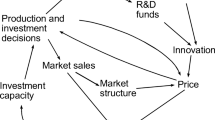Abstract
In this paper a model of technological evolution based on replicator dynamics is developed. Such a model is based on a twin characteristics representation of product technology and on a population approach. The model can give a general representation of technological evolution, but this paper concentrates on the relationship between variety and competition. Variety is considered to be a very important variable influencing economic development. By means of the characteristics and population approach adopted in this paper it is possible to distinguish between inter-and intra-technology competition. In this paper it is demonstrated that the variety of the system can only increase if intra-technology competition is more intense than inter-technology competition. Intuitively this implies that new technologies will only be able to emerge if incumbent technologies experience the competition coming from the new ones to be weaker than their own internal competition.
Similar content being viewed by others
References
Allen PM, McGlade JM (1987) Modelling complex human systems: a fisheries example. Eur J Operational Res 30: 147–167
Allen PM, McGlade JM (1987) Evolutionary drive: the effect of microscopic diversity, error making and noise. Foundations Physics 17: 723–738
Arrow K (1962) The economic implications of learning by doing. Rev. Econ Studies 9: 155–173
Bruckner E, Ebeling W, Scharnorst A (1989) Stochastic dynamics of instabilities in evolutionary systems. Systems Dynamics Rev 5: 176–191
Chamberlin EH (1966) The Theory of monopolistic Competition. Havard University Press (Original edition 1993)
Cohen M, Levinthal D (1989) Innovating and learning: the two faces of R& D. Econ J 99: 569–596
Cohen M, Levinthal D (1990) Absorptive capacity: a new perspective on learning and innovation. Administrative Sci Q 35: 128–152
David PA (1975) Technical Choice, Innovation and Economic Growth. Cambridge University Press, Cambridge
Eigen M, Schuster P (1979) The hypercycle: A Principole of Natural Self-organization. Springer. Berlin Heidelberg New York
Eldredge N, Gould SJ (1972) Punctuated equilibria: an alternative approach to phyletic gradualism. In: Schopf TJM (ed) Models of Paleobiology. Freeman Cooper, San Francisco, pp 82–115
Eldredge N, Gould SJ (1988) Punctuated equilibrium prevails. nature 332: 211–212
Foray D (1991) Towards an economic analysis of the organisations of research and development. Revue d'Economic Politique 101: 779–808
Hofbauer J, Sigmund K (1988) The Theory of Evolution and Dynamical Systems. Cambridge University Press. Cambridge
Hotelling H (1929) Stability in Competition. Econ J 39: 41–57
Mani GS (1980) A Darwinian theory of enzyme polymorphism. In: Mani GS (ed) Evolutionary Dynamics of Genetic Diversity Lecture Notes in Biomathematics 53: p 242–298, Springer Berlin Heidelberg New York
Mani GS (1989) Avoiding Chaos (letter to the editor). Trends in Ecol Evolu 4: 239–240
Maynard Smith J (1974) Models in Ecology. Cambridge University Press, Cambridge
Metcalfe JS, Gibbons M (1989) Technology, variety and organisation: a systematic perspective on the competitive proces. Res Technol Innovation Management Policy 4: 153–193
Mokyr J (1990) Punctuated equilibria and technological progress. Am Econ Assoc (Papers and Proceedings), pp. 350–354
Mokyr J (1990) The Lever of Riches: Technological creativity and Economic Progress. Oxford University Press. New York
Mokyr J (1991) Evolutionary biology, technological change and economic history. Bull Econ Res 43: 127–149
Mosekilde EJ, Rasmussen S (1983) Random Processes in Systems Dynamics. Dynamics 61: 33–39
Nelson R, Winter W (1982) An Evolutionary Theory of Economic Change. Harvard University Press, Cambridge, Mass
Pasinetti LL (1981) Structural Change and Economic Growth. Cambridge University Press, Cambridge
Pasinetti LL (1993) Structural Economic Dynamics. Cambridge University Press, Cambridge
Rosenberg M (1982) Inside the Black Box: Technology and Economics. Cambridge University Press, Cambridge
Roughgarden J (1979) Theory of Population Genetics and Evolutionary Ecology: an Introduction. MacMillan, New York
Saviotti PP (1988) Information, variety and entropy in technoeconomic devlopment. Research Policy 17: 89–103
Saviotti PP (1991a) Technological evolution, product characteristics, competition and variety. Presented at the Colloquium Management of Technology, Paris, May 27–28, 1991
Saviotti PP (1991b) The role of variety in economic and technological development. In: Saviotti PP, Metcalfe JS (eds) Evolutionary Theories of Economic and Technological Change: Present State and Future Prospects. Harwood Publisher. London
Saviotti PP (1992) Variety, economic and technological development. Presented at the Conference of the International Schumpeter Society, Kyoto, Japan, August 1992
Saviotti PP, Mani GS (1993) A model of technological evolution based on replicator dynamics. Presented at the conference: Developments in Technology Studies: Evolutionary Theories and Chaos Theory, May 6–8, Amsterdam
Saviotti PP, Metcalfe JS (1984) A theoretical approach to the construction of technological output indicators. Research Policy 13: 141–151
Saviotti PP, Metcalfe JS (eds) (1991) Evolutionary Theories of Economic and Technological Change: Present State and Future Prospects, Harwood Publishers, London
Schumpeter J (1934) The Theory of Economic Development. Harvard University Press, Cambridge, Mass (Original edition, 1912)
Schumpeter J (1942) Capitalism, Socialism and Democracy. George Allen & Unwin, London
Author information
Authors and Affiliations
Rights and permissions
About this article
Cite this article
Saviotti, P.P., Mani, G.S. Competition, variety and technological evolution: A replicator dynamics model. J Evol Econ 5, 369–392 (1995). https://doi.org/10.1007/BF01194367
Issue Date:
DOI: https://doi.org/10.1007/BF01194367




